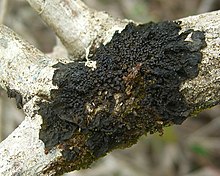Collemataceae
| Collemataceae | |
|---|---|

| |
| Collema nigrescens | |
| Scientific classification | |
| Domain: | Eukaryota |
| Kingdom: | Fungi |
| Division: | Ascomycota |
| Class: | Lecanoromycetes |
| Order: | Peltigerales |
| Family: | Collemataceae Zenker (1827) |
| Type genus | |
| Collema F.H.Wigg. (1780)
| |
| Genera | |
|
Blennothallia | |
The Collemataceae are a lichenized family of fungi in the order Peltigerales. The family contains ten genera and about 325 species.[1] The family has a widespread distribution.[2]
Taxonomy
[edit]The family was circumscribed by Jonathan Carl Zenker in 1827; Collema is the type genus.[3][4]
Description
[edit]Collemataceae members have a thallus that is either foliose, crustose, squamulose or minutely shrubby. The thallus is gelatinous, sometimes swelling when wet, with a colour ranging from dark olive-green to brown-black, reddish brown or rarely grey-blue. The upper and lower cortex is either absent or composed of angular brick-like cells, more rarely of flattened compressed cells. The medulla contains loosely interwoven narrow hyphae or is compact with broad-short-celled hyphae; these hyphae are intermixed with the photobiont. The texture of the upper cortex surface ranges from smooth to wrinkled or ridged, and is often glossy, but rarely arachnoid. The underside of the cortex is smooth, arachnoid or hairy, sometimes with scattered hapters or groups of white rhizines. Isidia are often present, while soredia are absent. The photobiont partner is Nostoc (rarely Stigonema), with their cells often arranged in distinct chains.[5]
Genera
[edit]This is a list of the genera in the Collemataceae, based on a 2020 review and summary of fungal classification by Wijayawardene and colleagues,[1] and including a new genus, Hondaria, circumscribed in 2020.[6] Following the genus name is the taxonomic authority (those who first circumscribed the genus; standardized author abbreviations are used), year of publication, and the number of species:
- Blennothallia Trevis. (1853) – 4 spp.
- Callome Otálora & Wedin (2013) – 1 sp.
- Collema Weber ex F.H.Wigg. (1780) – ca. 35 spp.
- Enchylium (Ach.) Gray (1821) – 11 spp.
- Hondaria Kitaura & A.P.Lorenz (2020)[6] – 1 sp.
- Lathagrium (Ach.) Gray (1821) – 10 spp.
- Leptogium (Ach.) Gray (1821) – ca. 110 spp.
- Pseudoleptogium Müll.Arg. (1885) – 1 sp.
- Rostania Trevis. (1880) – 3 + 4 orphaned spp.
- Scytinium (Ach.) Gray (1821) – 49 spp.
References
[edit]- ^ a b Wijayawardene, Nalin; Hyde, Kevin; Al-Ani, Laith Khalil Tawfeeq; Somayeh, Dolatabadi; Stadler, Marc; Haelewaters, Danny; et al. (2020). "Outline of Fungi and fungus-like taxa". Mycosphere. 11: 1060–1456. doi:10.5943/mycosphere/11/1/8. hdl:10481/61998.
- ^ Cannon PF, Kirk PM (2007). Fungal Families of the World. Wallingford: CABI. p. 82. ISBN 978-0-85199-827-5.
- ^ Goebel, F.; Kunze, G. (1827). Pharmaceutische Waarenkunde. Vol. 1. Eisenach: Bärecke. p. 124.
- ^ Otálora, Mónica A.G.; Jørgensen, Per M.; Wedin, Mats (2013). "A revised generic classification of the jelly lichens, Collemataceae". Fungal Diversity. 64 (1): 275–293. doi:10.1007/s13225-013-0266-1.
- ^ Cannon, P.; Otálora, M.A.G.; Košuthová, A.; Wedin, M.; Aptroot, A.; Coppins, B.; Simkin, J. (2020). "Peltigerales: Collemataceae, including the genera Blennothallia, Callome, Collema, Enchylium, Epiphloea, Lathagrium, Leptogium, Pseudoleptogium, Rostania and Scytinium". Revisions of British and Irish Lichens. 2: 1–38. doi:10.34885/174.

- ^ a b Kitaura, Marcos Junji; Scur, Mayara Camila; Theodoro, Josiane Vogel Cortina; Piovezan-Borges, Ana Cláudia; Lorenz, Aline Pedroso (2020). "Hondaria, a new genus of Collemataceae (Ascomycota lichenized) from South America". Acta Botanica Brasilica. 34 (4): 615–622. doi:10.1590/0102-33062020abb0093.
